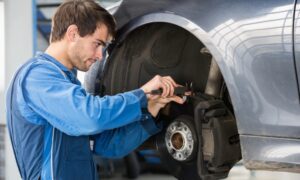Jaguar cars have long been associated with luxury and performance, but certain models and years have been noted for mechanical and electrical issues that can challenge their reliability. Recognizing the most problematic Jaguar models and the common issues they face is crucial for owners and potential buyers. Issues such as transmission glitches in models like the X-Type or the suspension troubles often seen in older vehicles highlight the importance of understanding these cars’ idiosyncrasies. Knowing the most troubled years and models helps in making informed decisions when purchasing a Jaguar or maintaining one’s current vehicle.
Addressing common problems requires a combination of troubleshooting skills and preventative maintenance. Easy resolutions often start with accurate diagnosis, followed by following specific repair steps, which may include both DIY fixes or professional assistance. Investing in a comprehensive workshop manual can be invaluable, as it provides detailed guides for repair and maintenance tasks, potentially saving time and money on costly service visits. For owners committed to their Jaguar’s upkeep, these manuals are an essential resource in maintaining their car’s elegance and performance.
Key Takeaways
- Certain Jaguar years and models are prone to specific reliability issues.
- Effective resolutions often involve detailed troubleshooting and maintenance.
- Workshop manuals are critical for cost-effective Jaguar maintenance and repair.
Most Problematic Jaguar Models and Years
Certain models and years of Jaguar vehicles have garnered attention for their reliability issues. This section details the most common problems associated with these models, emphasizing the need for owners to be aware and prepared for potential issues.
Jaguar X-Type Common Issues
The Jaguar X-Type, particularly those produced between 2001 to 2009, faced several issues. Problems such as transmission failure, oil leakage, and faulty all-wheel-drive components were commonplace. Early models were especially known for their electrical troubles, illustrating the teething problems of this entry-level luxury car.
Jaguar S-Type Recurring Problems
Owners of the Jaguar S-Type have reported cooling system failures leading to engine overheating, as well as issues with the automatic transmission. Models from 2000 to 2008 have also suffered from suspension problems, resulting in costly repairs and sporadic electronic glitches affecting various in-car systems.
Challenges with Jaguar XF
The Jaguar XF has had its share of problems, particularly in models from 2007 to 2015. Owners often cite faulty hose clamps that can lead to engine stalling and overheating as a significant concern, along with electronic issues such as a digital instrument cluster going blank or a sat-nav system malfunctioning.
Jaguar XJ Reliability Concerns
Reliability concerns for the Jaguar XJ stem mainly from the models produced in the early 2010s. High-mileage reports indicate sporadic issues with engine performance, as well as airbag failures and occasional fuel leaks in diesel models. Such problems can be pervasive, affecting the overall dependability of this luxury sedan.
Jaguar XK Technical Setbacks
The Jaguar XK series, notably those produced from 2006 onwards, included cooling system failures, which could cause serious engine damage. Additionally, owners have encountered electronic malfunctions and issues with interior materials that do not meet the expectations of durability for a car of its class.
Each of these Jaguar models exhibits specific weaknesses that owners and potential buyers should be cognizant of. A workshop manual can be an invaluable resource for diagnosing problems accurately and guiding users through cost-effective repairs.
Common Mechanical and Electrical Issues
Jaguar vehicles are renowned for their luxurious appeal, yet they are not without their fair share of mechanical and electrical issues. Jaguar owners frequently encounter problems that span across various models and years, affecting engines, transmissions, suspension systems, and electrical components.
Engine Troubles Across Models
Several Jaguar models have experienced engine-related issues. One of the most critical problems includes premature engine stalling where the engine might fail to restart, or in extreme cases, overheat due to faulty hose clamps leading to coolant loss. Resolving engine troubles often involves inspecting for loose components and repairing any detected leaks promptly to prevent major damage.
Transmission and Gearbox Complications
Jaguar models, especially ones from certain production years, may exhibit transmission glitches, such as rough shifting or unexpected gear engagement. Some cases may warrant a software update, while others could require physical transmission repairs or replacements. A workshop manual can guide owners through troubleshooting steps and offer detailed repair instructions.
Suspension System Failures
Suspension problems are notable in Jaguars, with signs including uneven tire wear or poor handling. Worn bushings, struts, and shock absorbers are common culprits. Addressing suspension issues can restore ride quality and extend the lifespan of tires. Manuals are helpful for identifying the specific suspension components that need attention according to the model.
Electrical System Defects
Jaguars are often plagued by electrical gremlins which manifest in various forms such as malfunctioning sensors or errant warning lights. Electrical problems may cause erratic behavior and starting difficulties. Prompt diagnosis and fixing of electrical issues, referring to wiring diagrams in a workshop manual, can help avoid more serious malfunctions.
Interior and Exterior Challenges
Jaguar vehicles, while celebrated for their luxury and performance, also face some interior and exterior challenges. These can vary by model and year, but some issues arise more frequently than others, affecting the vehicle’s durability and safety.
Leaks and Corrosion
Jaguars are sometimes susceptible to water leaks, which can lead to rust and corrosion. Certain models are known for developing leaks that allow water to seep into the cabin, specifically through door seals and sunroofs. This moisture can cause electrical components within the door panels to malfunction and can also lead to mold growth. Rust tends to occur not only on the bodywork but critically in areas like wheel arches and the undercarriage, potentially compromising the structural integrity of the vehicle.
Common Solutions:
- Regularly inspect seals and apply sealant if necessary.
- Keep drain channels clear of debris.
Airbag and Seatbelt Issues
Regarding safety, faulty airbags have been a notable issue. They may deploy unexpectedly or fail to deploy in the event of a crash, posing serious risks. Additionally, seatbelt mechanisms may malfunction, failing to secure the occupant properly during a collision.
Common Solutions:
- Schedule regular safety checks for airbag systems.
- Get immediate professional assistance if warning lights indicate faults.
Purchasing a workshop manual specific to the model in question can help Jaguar owners diagnose these issues early and facilitate more efficient repairs. By following a manual, they may pre-empt potential problems, ultimately saving time and money on maintenance.
Troubleshooting and Resolutions
Jaguar owners frequently encounter specific issues related to engine performance, cooling, suspension, and electrical systems. Addressing these problems efficiently can minimize repair costs and prevent further damage to the vehicle.
Addressing Engine Misfires and Power Loss
When a Jaguar experiences engine misfires or a loss of power, it could be due to ignition coil failure. One should test the ignition coils using a multimeter for resistance and replace any coil that does not meet the specifications. Regular maintenance, such as replacing spark plugs and fuel filters, can also prevent these issues.
Fixes for Cooling Problems
Experiencing overheating can often be traced back to issues within the cooling system, such as faulty hose clamps or a compromised water pump. To mitigate these problems, regularly inspect hoses for secure fittings and intact clamps. Additionally, monitoring coolant levels and thermostat function is key to ensuring the engine remains at an optimal temperature.
Repair Methods for Suspension Woes
The suspension system in Jaguars may suffer from wear and tear that leads to a less comfortable ride. Owners should inspect bushings, control arms, and shock absorbers for signs of degradation. Replacing worn parts helps restore ride quality and reduces long-term repair costs.
Electrical System Diagnostic Tips
Electrical problems require a methodical approach to diagnose effectively. Begin by checking the battery health and ensuring all connections are secure. Use a diagnostic scanner to read fault codes, which can pinpoint specific malfunctions. Regular inspection of fuses and electrical wiring can preempt potential issues.
Purchasing a workshop manual specific to the Jaguar model in question facilitates accurate troubleshooting and can save both time and money. It provides detailed diagrams and step-by-step instructions for handling repairs, making it an invaluable resource for efficient problem-solving.
Preventative Maintenance and Care
Maintaining a Jaguar efficiently involves establishing a routine and knowing when to seek expert advice. Timely maintenance and understanding the specific needs of Jaguar models can prevent many common issues.
Effective Maintenance Routines
Regular maintenance is essential for keeping a Jaguar running smoothly and avoiding expensive repairs. Owners should adhere to a maintenance schedule that includes:
- Oil Changes: Every 5,000 to 7,500 miles to ensure engine longevity.
- Tire Rotation and Balancing: Every 6,000 miles to prevent uneven wear.
- Brake Inspection: Biannually to maintain optimal braking performance.
A tailored workshop manual can guide owners through the intricacies of their specific Jaguar model, providing detailed procedures and schedules. Investing in a quality manual can lead to substantial long-term savings by enabling owners to address minor issues before they escalate.
When to Consult a Dealer or Specialist
There are circumstances when professional intervention is prudent:
- In-Warranty Repairs: Always take the vehicle to an authorized dealer to avoid voiding the warranty.
- Advanced Diagnostics: If a Jaguar exhibits unfamiliar warning lights or behavior, consulting a dealer can prevent misdiagnosis.
- Specialized Repairs: For complex problems, such as those related to the transmission or onboard computers, specialist care is often more cost-effective in the long term.
Understanding when and where to seek help maximizes the efficiency of the maintenance routine and ensures the longevity of the vehicle.
The Role of Workshop Manuals
When it comes to maintaining or repairing a Jaguar, having access to a comprehensive workshop manual is invaluable. These guides provide detailed instructions tailored to the specifics of the model, empowering Jaguar owners with the knowledge to tackle various issues confidently.
Benefits of Having a Detailed Guide
- Model-Specific Information: Workshop manuals offer extensive coverage tailored to the Jaguar in question, whether it’s routine maintenance or more complex repairs. The manuals often include detailed diagrams and step-by-step instructions, ensuring that enthusiasts and owners handle their vehicles correctly and effectively.
- Improved Performance: By adhering to the recommended procedures found in these manuals, one can maintain their Jaguar’s performance at optimal levels. From engine tuning to suspension adjustments, the precise guidance they offer can lead to noticeable improvements in the vehicle’s handling and power delivery.
Saving Time and Money with DIY Repairs
- Reducing Repair Costs: By utilizing a workshop manual, Jaguar owners can avoid expensive labor costs associated with professional services. Instead, they can invest in the required tools and spend time working on their vehicles, which often leads to significant savings. We found https://downloadworkshopmanuals.com to have the most extensive selection and best prices.
- Valuable Investment: Purchasing a workshop manual is a smart investment that can pay for itself over time. Not only does it provide an opportunity for the owner to learn and understand their vehicle better, but it also equips them with the skills to prevent future issues, thus potentially averting costly repairs down the line.
Understanding Jaguar’s Market Value
When considering a Jaguar’s market value, one must take into account both its resale prospects and the potential value it offers as a used vehicle purchase. This insight is critical for buyers and sellers to make informed decisions.
Resale Prospects for Different Models
Resale value is a primary concern for any car owner, and Jaguar models are no exception. Historically, certain luxury cars tend to depreciate faster than economy vehicles. However, J.D. Power ratings suggest that select Jaguar models can maintain a reasonable resale value, particularly when well-maintained and free from the common issues that plague some model years. For instance, when it comes to used Jaguars, Kelley Blue Book provides comprehensive data that can help predict the depreciation rate for various models.
- Expected Depreciation: Luxury cars often see significant depreciation, but with diligent care, a Jaguar can retain more value than expected.
- Model-Specific Trends: Different model years and trims can affect resale value, so research on platforms like Kelley Blue Book, Edmonds or Car Resources is essential.
Investing in a Used Jaguar
Buying a used Jaguar can be a smart investment with a thorough understanding of the vehicle’s history and condition. Resale value becomes a more nuanced affair with used vehicles. Tools such as CoPilot compare market rates, providing a clearer image of what one should pay for a used Jaguar.
- Market Comparison: Utilize resources like CoPilot to assess the market value of the specific Jaguar model you are interested in.
- Historical Reliability: Examining past reliability can give insights into potential future expenses, which affects value.






























